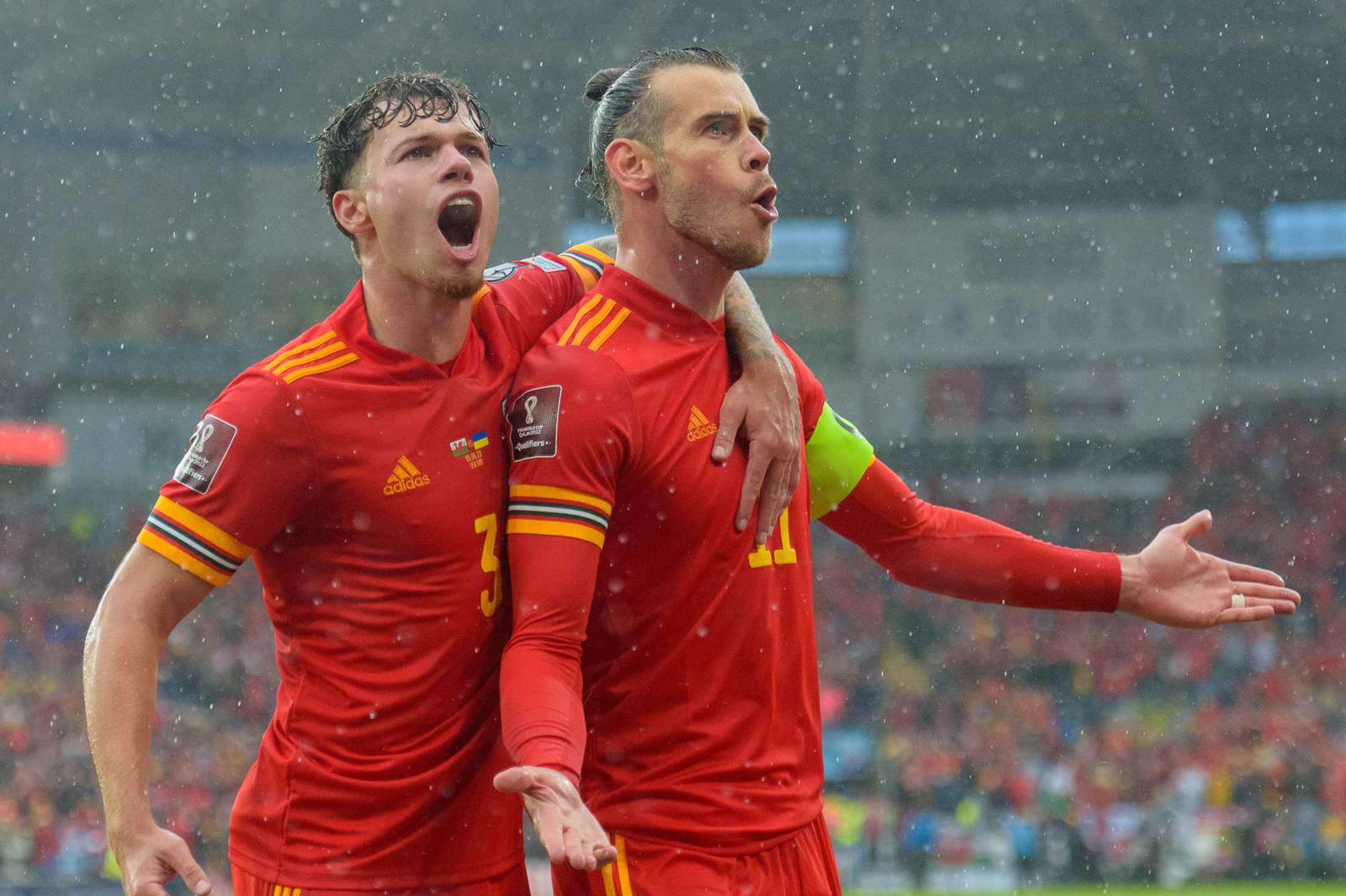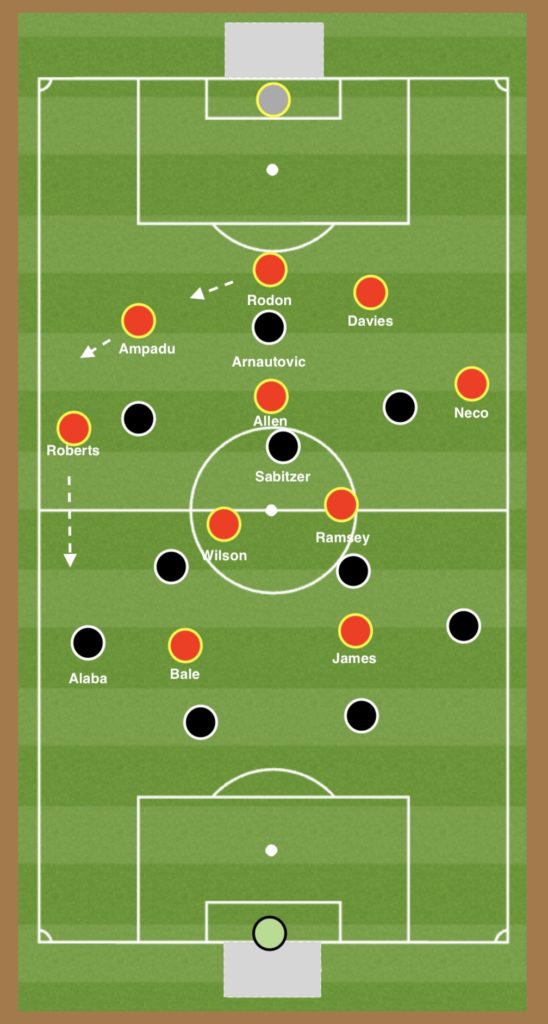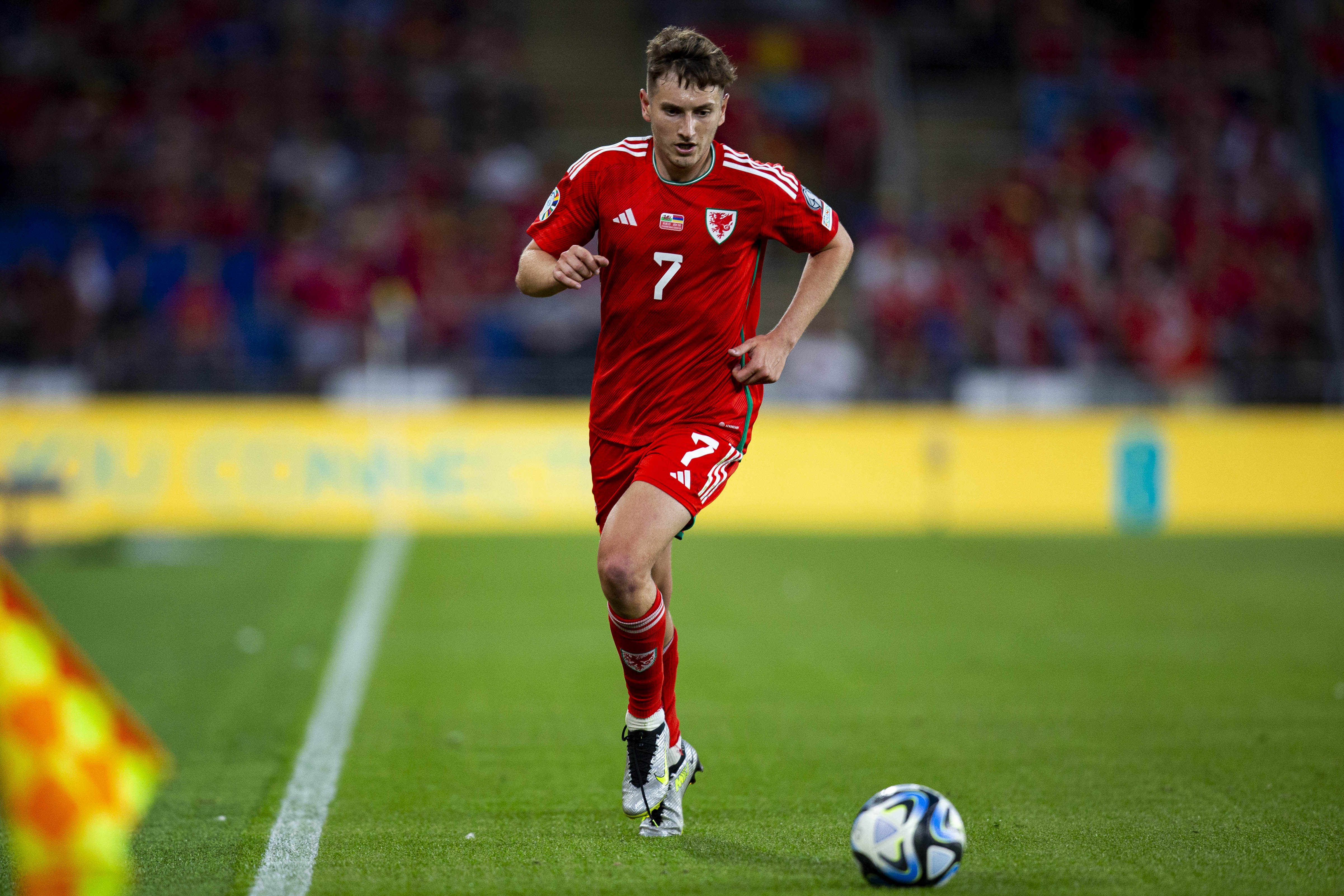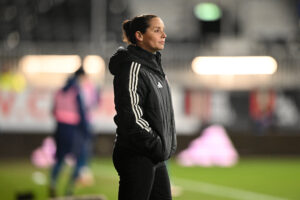The Key Tactics Explained as Wales Qualify for World Cup 2022

Wales 1-0 Ukraine in the FIFA World Cup Play-Off Final at the Cardiff City Stadium on June 5, 2022. Credit: Will Cheshire
All the most epic film scenes happen in rain. Shawshank Redemption’s Andy Dufresne escapes prison and throws his arms to the sky, The Matrix’s Neo saves the world from legions of Agent Smith, Jim Carrey escapes the Truman Show across the ocean, all in torrential downpour. The pounding of heavy rain adds a feeling of foreboding, even dread. It can also convey a sense of cleansing after an agonising past. Of course it chucked it down in Cardiff on Sunday.
After 95 minutes in the rain it was a tactically fascinating 1-0 win for Wales. It followed the 2-1 victory over Austria at the same venue, where both play-off games were tense matches against strong sides.
Here we look tactically at how Wales recorded these wins and made it to World Cup 2022.
Austria
The game was an absorbing contest of contrasting formations. Wales set up in their favoured 3-5-2 formation, with Austria in a 4-2-3-1. Attacking midfielders Wilson and Ramsey played either side of Joe Allen in midfield. Bale and James played ahead of them. Page first used this approach in the October 2021 International break in the games against Czech Republic and Estonia. Ramsey and Wilson had demonstrated they offered enough defensively to be played together in the 3 man midfield.
Ranked 31st in the world Austria are a difficult opponent, having recently taken Euro 2020 champions Italy to extra-time in last summers knock-out stages. They typically play Bayern Munich’s Marcel Sabitzer as playmaker behind frontman Marko Arnautovic.
The Welsh game plan focussed on one man. A superstar at Real Madrid and captain of his country, a man possessing multiple champions league winners medals and a wand of a left foot.
That man, was David Alaba.
Alaba is comfortably the best player in the Austrian side. In Guardiola’s days coaching him at Bayern Munich he described Alaba as ‘brilliant as a left winger’, and utilised Alaba widely, stating he played him in ‘almost all 10 positions’.
Anyone unsure of Alaba’s quality might watch his screamer from October’s El Clasico when playing at centreback. A goal he started by winning the ball just outside his own box and then finished 13 seconds later into the top corner. A truly incredible goal.
With Austria he typically lines up at left back and they look to build down his flank. He both gets into advanced left sided positions and drifts inside to create chances.
Wales looked to stop him at source. Within a minute Connor Roberts flew up from wingback to press him, winning the ball. Dan James’ resulting shot was saved. Austria composed themselves before trying to pass the ball out from the back. As Goalkeeper Lindner passed to Alaba, Roberts flew up again. As Roberts pressed Neco tucked in on the left, the back 5 moving pendulum-like to become a back-4.
This happened for a third time within the first 3 minutes. Ampadu followed in behind Roberts covering the Austrian winger that Roberts had left, and as Alaba was forced to move the ball on over the top, Rodon swept up the wide right space remaining.
This continued throughout the first 45 minutes. At half time Austria made sure the second half was different. Not once in the first half did Austria manage to advance Alaba into the Wales final third. They did it 3 times in the first 10 minutes of the second half, through quickly switching play from the right flank via central areas (typically through number 10 Sabitzer) and out to the left. This worked because as Neco was drawn out to play on the Austrian left, Roberts tucked in, as the back-5 pendulum swung across the other way. This left space for Alaba to advance. Austria threatened more second half.

Football writer Daniel Storey described Bale’s first goal as ‘One of the best free kicks of all time’ given the occasion, pressure on the player and difficulty of the position of the free kick. On 51 minutes Bale lost Alaba at a corner to get a half-chance that again had to go right in the top corner, and did. On 55 minutes and now 2 goals down, Austria looked to threaten from the crosses now coming in from Alaba. The 6’7 Sasa Kalajdzic came on, joining the 6’4 Marko Arnautovic up top. Rodon swapped to pick him up at the next corner leaving Ampadu with Arnautovic. Wales kept men behind the ball and threatened on the counter, ultimately seeing the game out. Rodon was imperious throughout.
A finger tip save denied Brennan Johnson his first goal for Wales and as it did the Cardiff City stadium erupted with joy. The clock read 94:25. Finally the chorus of whistles from the crowd had been met with one from the referee. One down, one to go.
Ukraine
For the play-off final Rob Page stuck with the same 3 centreback system Wales have played in their last 5 competitive games. Though here Page played more 5–2-2-1 formation, the 4 midfield players forming a box shape behind central striker Moore. Page bravely put all his best attacking players in the side, even giving Ramsey license to break forward from defensive midfield. This contributed to making it a very open game.
Ukraine played their fluid 4-3-3. In their first play-off game Wales got to warm up against a back 4 system in the 2-1 win over Austria. Ukraine likewise got an appropriate practice run for the final, playing Scotland’s back-5 system last week. After these games a number of interesting tactical changes were made to gain the advantage. Both sides created many chances in an open game that was great for the neutral.
Usually wingers stay wide to stretch the pitch in a 4-3-3, as typified by Pep Guardiola’s Barcelona side from 2008-2012. Interestingly in Ukraine’s 4-3-3 the wingers on both sides repeatedly move in from their touchline. Ukraine then look to create by breaking through the oppositions defensive lines in central areas. This caused Scotland a lot of problems, as Page alluded to post-match. If Ukraine lose the ball in these areas, they instantly counter-press hard to win it back, knowing they likely have numerical superiority there. As Jurgen Klopp has said, ‘No playmaker in the world can be as good as a good counter-pressing situation’. After winning the ball back Ukraine looked to create against a now disorganised defence.

Page’s response was to sit his two most technical centre midfielders (Allen and Ramsey) in front of the 3 centre backs. Both Allen and Ramsey covered almost 12km battling outnumbered in these areas, well above the distance you’d expect in 90 minutes. James and Bale also dropped centrally when out of possession, and looked to counter attack once possession was won back.
Wales didn’t sit deep until late in the game, more often defending in a ‘mid-block’, further helping to congest the central areas Ukraine looked to play in.
This generally worked well. Twice in the first 15 minutes it was clear that Rodon was much quicker than Ukrainian 9 Yaremchuk, this reduced the threat of Ukraine playing in behind the mid-block. Ukraine soon realised this and had more success through direct passes to Yaremchuk who then flicked it on to a third player who had run from deeper.
Ramsey lost possession on a few occasions under the Ukrainian counter-press in congested midfield areas. He was far from the only Wales player, with Bale and even Joe Allen losing possession in the counter-press a few times. Wales looked long to Kieffer Moore to break the press, but frequently overhit these passes. Wales looked dangerous once in the Ukrainian half. As against Austria Wales swung their pendulum back-5 to Connor Roberts’ side, but this time in attack. Bale tucked in, Roberts overlapped, while Dan James offered the left sided width with Neco. A number of crosses were aimed deep to Moore at the back post but again a lack of quality didn’t give him lots to work with.
Wales also threatened at corners, though didn’t win many throughout the game (4 only). Against Austria Wales had some success with a 2 man short corner routine. The taker passing short then overlapping the second man to cross from a more advantageous position. One led to Bale’s second goal. Spotting this Ukraine put 2 players out to match up with Wales’ 2 at corners, but this left them a defender short for the cross.
Overall Wales created best in counter attacks on the ground, particularly in the second half as Ukraine chased an equaliser. Brennan Johnson’s pace was well suited to the counter attacking game when he came on. It was a contest where both teams had figured out how to create dangerous moments, though neither had quite figured out how to completely stifle their opponent. Chances continued at both ends until the final whistle. Ben Davies and Hennessey both deserving the plaudits for key interventions to get Wales over the line.
Looking ahead
Two games and two wins then in a Golden Age of Welsh football. Rob Page was tactically astute again, making big calls that contributed significantly to the wins.
Now we can all look ahead to Wales’ first World Cup for 64 years, with more epic Welsh football moments sure to come in Qatar. Though it certainly won’t be raining.
(Featured image: Will Cheshire)







